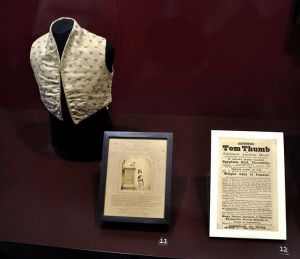Disability History Seminar
Ross MacFarlane (Wellcome Trust)
Herr Winkelmeier, Tom Thumb and the Hilton Sisters: Uncovering the ‘freaks’ of the Wellcome Library
This is a guest post by Charlotte De Val, one of IHR Digital’s interns from the University of Leicester.
The Wellcome Library, situated London, is one of the world’s major resources for the study of medical history. In this seminar Ross MacFarlane (Wellcome Trust) explores the nineteenth-century posters and hand bills advertising ‘freak shows’ in the ephemera collection. These advertisements are used to explore the representation of performers, the relationship they had with their ‘masters’, performer agency and disability terminology. The Wellcome Library has a particularly interesting context for these ‘freak shows’; while many collections, such as the V&A theatre archive, contextualise them under performance theatre, the Wellcome Library provides a fascinating medical approach.
Under this medical context, MacFarlane discusses nineteenth-century terminology (‘freak of nature’ etc.) and the modern descriptor ‘disabled’. In the 1980s, scholars re-assessed the phrase ‘freak of nature’; the social construction of the word ‘freak’ inherently considers the performers un-natural and therefore, they concluded, they are in fact ‘freak(s) of culture’. As for the term ‘disabled’ (first used in reference to war victims), MacFarlane urges consideration in its application to ‘freak show’ performers, since some traits are not necessarily considered to be a disability and it has some problematic modern connotations. Such an approach to terminology came with the revision of the assumed victim/agent binary; while MacFarlane stresses that we must not wholly accept the ‘rosier’ picture revisionist history paints, he does provide evidence to complicate the assumed exploitation. Within the wider historiography, MacFarlane picks up his discussion with Richard Altick’s study, The Shows of London (1978), which identified the nineteenth-century shift in ‘freak shows’ from open-air shows in seasonal fairs to permanent urban establishments.
MacFarlane deliberately uses lesser-known performers and materials that have not yet been digitised to avoid familiarity. Amongst many small examples from the collection, the first performer discussed in depth is General Tom Thumb (born Charles Sherwood Stratton), who, having not grown since he was six months old, was signed by P.T. Barnum at the age of four. Analysing their performer/master relationship, MacFarlane addresses the problematic narrative presented in Barnum’s autobiography. Tom Thumb’s courtship and wedding with fellow performer Lavinia Warren is also given significant attention, as is the role of photography in the industry which juxtaposed normative images with extraordinary bodies.
Herr Winkelmeier, an Austrian ‘giant’, is MacFarlane’s second example. Giants were considered particularly exotic, which is evident in the use of foreign national dress, flags etc in advertisements. MacFarlane also discusses the contrasting careers of giants and midgets; while a giant’s height was the main attraction, midgets were taught to sing, dance and display other talents. Herr Winkelmeier advertisements also display the equal standing with other forms of entertainment, having appeared on a poster with comedian Harry Randall.
Finally, MacFarlane discusses conjoined twins Daisy and Violet Hilton. The Hilton Sisters, famed as the first surviving UK-born conjoined twins, gained considerable medical interest and therefore particularly appropriate within the context of the Wellcome Library. Furthermore, MacFarlane highlights the public interest in the sexuality and domesticity of conjoined twins; popular accounts of the Hilton Sisters (and other conjoined twins) often contained commentary on their sex lives.
In conclusion, MacFarlane returns to the transformation of ‘freak shows’ from outdoor entertainment to a respectable, permanent industry even appearing in films. By exploring advertisement methods, the proximity to other forms of entertainment and medical interest in the industry, MacFarlane aims to widen the discussion of issues that apply to ‘freak shows’ generally.


